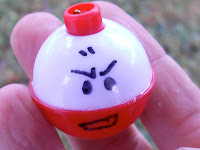As I mentioned before, just because you got a fishing rod, you are not quite ready to start reeling in the lunkers. The easiest way to start is with live bait. It requires the least gear, and you can catch a wide variety of fish, but you’re gonna need something to tie onto the end of your new line, as well as things to make your bait float... or sink.
Let’s talk about line. The line on that flea market rod might be older than you! Ideally, your fishing line should be replaced every year. The line starts to act a little crazy as it gets older. It becomes much more likely to tangle, hard to cast accurately, knots won’t hold, and it becomes brittle and more likely to break. Fishing line is usually sold with a rated breaking strength and the diameter on the package. When choosing new line, choose the lightest line you are comfortable using. If you plan on catching bluegill or perch or other panfish, you can probably do just fine with three pound test. If fishing for big catfish, you might go with twenty pound test. I personally never use anything above ten pound test. There is a trade off. As your line gets heavier, you will have less strikes because the fish are more likely to see your line. Heavier line is also harder to cast than light line. There are so many different choices for line, and they are changing constantly. There is monofilament, fluorocarbon, superbraid... maybe someday we’ll have nanotube line! What I usually find myself buying is Yo-Zuri Hybrid, it’s a nylon monofilament and fluorocarbon hybrid. I usually use six pound test for all around conditions.
 |
| Click to enlarge |
Now, you need to be able to present your bait at the proper depth. This is where sinkers and floats (or bobbers) come in. Sinkers are usually made of lead. Lead is cheap, heavy, soft and easily molded, and terrible for the environment. If you are trying to be environmentally friendly, there are lead alternatives. Tungsten, steel, or tin are used to make lead free sinkers. Tungsten and steel are heavy, but too hard to mold, so they usually come in shapes that would be tied onto your line. Tin is softer, but not as heavy. Since it is softer, it is available in split shot. Split shot is clamped onto your line easily with a pair of pliers. (Don’t use your teeth, especially with lead split shot.) If you are just going to fish on the bottom for big bottomfeeders, the sinkers will get you where you are going. However, if you are fishing for sunfish, bluegill, largemouth bass, and other fish along those lines, you might need to present your bait suspended between the surface and the bottom, because that is where most fish live. Putting a float on your line anywhere from ten inches to about six feet up from the hook, with a couple of split shot somewhere in between (make sure your float is buoyant enough to float with your weight) will suspend your bait at a good average depth. Floats come in all sorts of designs, but the most common kinds are either long balsa floats, or plastic spheres that look just like Poké Balls from Pokémon. The video game nerd in me loves the Poké Ball floats. I can draw little faces on them and make them look like Voltorb and Electrode, or just pretend i’m throwing out a Poké Ball to catch a Magikarp. Gotta catch ‘em all! Really I see no advantage over one type of float or another. If anyone has an opinion over what type of float is better for any occasion over another, please share.
 |
| My Voltorb float |
 |
| My Electrode float |
Finally, bait. Probably the simplest option would be to use earthworms. In my hometown of Muskegon, Michigan you could buy worms and many other kinds of live bait at any gas station. In Milwaukee, live bait is much harder to find in stores, but who needs to buy live bait? Plan ahead, save a glass jar and put some nice moist black soil in it, then wait for a soaking rain. When the rain has cleared, get out there and start collecting your bait from the sidewalk before the birds get it all! Alternately, if there is a wooded area near you, you can turn over stumps and logs. You have to be quick, earthworms are pretty photophobic and will dart into the soil faster than you thought possible. Many nightcrawlers can be found under logs; a nightcrawler is a very large earthworm used for fishing. There are almost endless possibilities for live bait. You can use minnows, crickets, maggots, mayflies and their larvae, leeches, frogs and so many others. According to my dad, my great-grandfather used to fish for musky with live squirrels, i’m not sure if that’s even legal! I have also heard of kittens being used as shark bait. I am strongly against this. Personally, the most advanced life form I think that should be used for bait is live fish. Anything more advanced than fish just seems to be cruel, you have to draw a line somewhere.
Once you have acquired all of these things, you are pretty much ready to start fishing! There is actually one more crucially important thing, you need a fishing license, well, at least in the USA you do. Prices, as well as laws vary from state to state, so read your state’s guidebook. If you get caught fishing without a license YOU WILL REGRET IT!
Fishing with live bait can be a lot of fun, but there might come a time when you want to switch to artificial bait. Artificial bait and lures will be discussed at a later point. Now, go catch some fish!


No comments:
Post a Comment